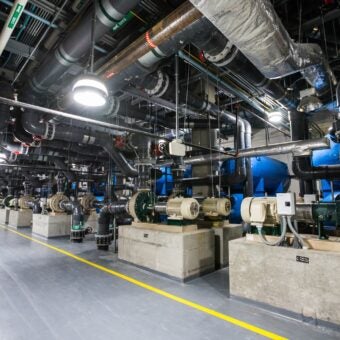-
Size
Up to 37 inches (95 cm) -
Diet
Mollusks, crustaceans, insects, fishes -
Range
North and South America -
Habitat
Bottoms of medium to large rivers and lakes
Physical Characteristics
- The freshwater drum is brown-gray in color, with silver sides and white below; dusky fins, except for the white pelvic fin.
- Grow up to about 37 inches (95 cm) and weigh up to 54 lbs. (24.5 kg).
- This is a rounded fish with a blunt snout and a humped back. The tail is rounded and small and the dorsal fin is deeply notched and extends from the back almost to the tail.
Animal Fact
The characteristic drumming or croaking sound is produced by the air bladder in sexually mature freshwater drum males.
Diet / Feeding
- Feeds on mollusks, crustaceans, insects, and fishes.
- Prefers mollusks and will search the bottom mud and debris for them. Flattened teeth at the back of the throat will crush hard shells, spitting out the shell fragments and swallowing the soft tissue.
- Although bottom-oriented in its feeding behavior, the freshwater drum consumes a considerable amount of fish.
Range / Habitat
- Occurs in North and Central America. Its range extends from the Rocky Mountains in the St. Lawrence-Great Lakes, Hudson Bay and Mississippi River basins from central Canada to the Gulf of Mexico, and through Mexico into Guatemala.
- Found on bottoms of medium to large rivers and lakes and prefers clear water, but can withstand a turbid environment, so also occasionally found in silty or muddy lakes and rivers.
Reproduction & Growth
- The characteristic drumming or croaking sound is produced by the air bladder in sexually mature males.
- Drumming is more frequent in early summer and it is believed that it is related to spawning behavior. It may be a signal that stimulates males and females to congregate in common areas to spawn.
Conservation Status
- “Least Concern” on the IUCN Red List.
Additional Information
- Also referred to as “sheeps-head” or “gaspergou.”
- It is the only freshwater fish on which the lateral line, a sense organ used to detect motion in the water, runs right through the tail.
- This species has the greatest north-south range of any North American freshwater fish.
- It is similar to its marine relative, the red drum, except for its coloration.
- The freshwater drum is a popular game fish and is considered tasty.
Sources
- www.tpwd.state.tx.us/fish/infish/species/fwd/fwd.htm
- www.seagrant.wisc.edu/greatlakesfish/drum.html
- www.dnr.state.mn.us/snapshots/fish/freshwaterdrum.html
- www.fishbase.org
- Peterson Field Guides – Freshwater Fishes. Page, L.M.; Burr, B.M., pg. 326
- McClane’s Field Guide to Freshwater Fishes of North America. McClane, A.J., pgs. 194 -195
- The Fishes of Tennessee. Etnier, D.A. ; Starnes, W.C., pgs. 602 – 603
- Fishes of Alabama. Boschung, H. T.; Mayden, R.L., pg. 605






